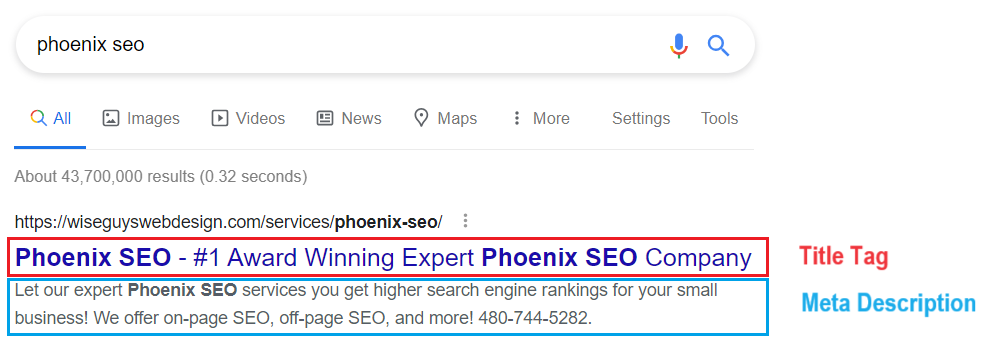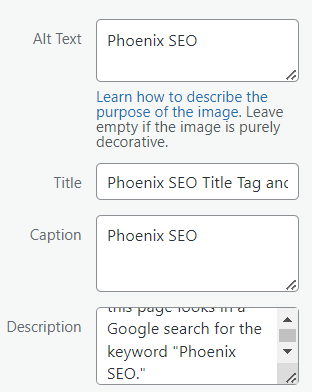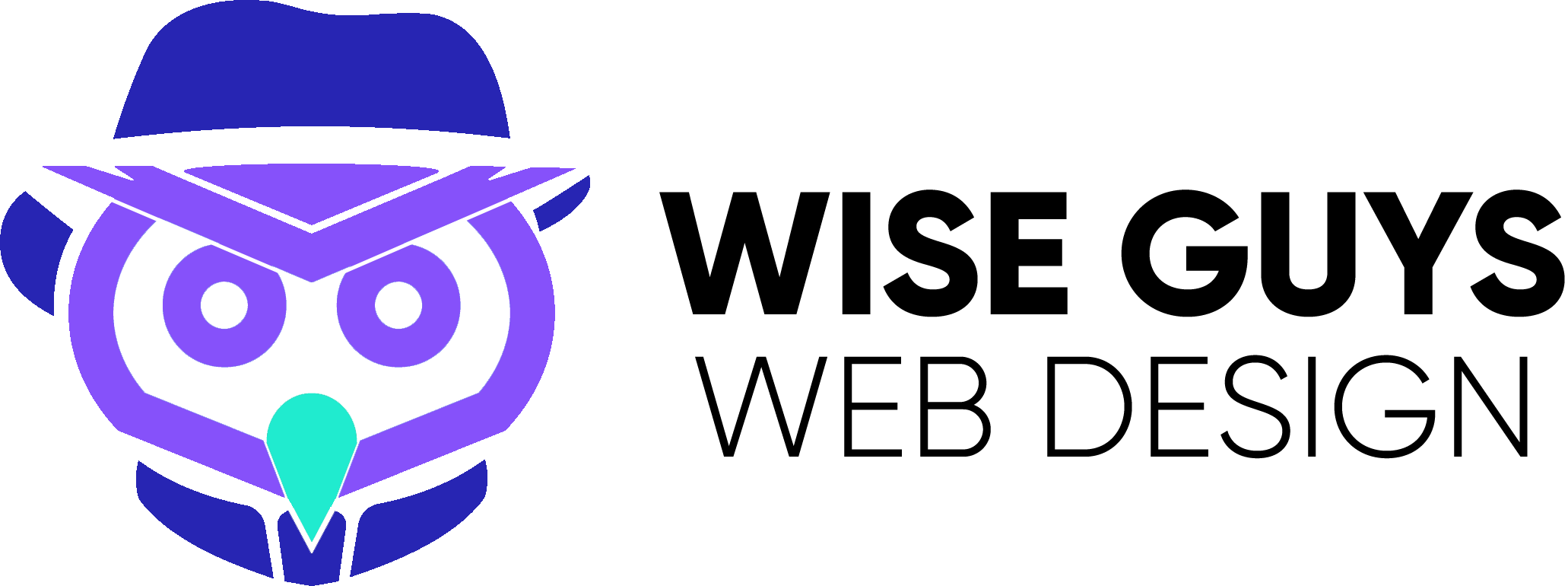Phoenix SEO
Phoenix SEO Services
With the internet being such a huge platform, it’s often difficult for small businesses to be seen in search engine results. This is especially true for those small businesses who do not have websites, but what about those that do have websites? How do they get found? The answer is simple: either through paid advertising (pay-per-click) or search engine optimization (SEO), which we will talk about here.
What is SEO?
Search engine optimization, better known as “SEO,” is a process in which search engines use algorithms and hundreds of data factors to determine how websites rank organically in search engine results. The term “organically” means that a website shows up in search engine results naturally, rather than paying for advertising placement (ex: Google Ads). Search engines have one common theme with SEO: provide users with the best experience possible.
According to Google themselves, there are over 200 factors that can determine a website’s search engine rankings! With so many factors to consider, it’s pretty apparent that SEO is not a simple thing to do. To get it right, you need to work with Phoenix SEO experts like Wise Guys Web Design! Being an award-winning SEO company, we have helped many local and out-of-state businesses rank at the top of the search engines for multiple keywords!
TRANSFORM YOUR BUSINESS
IN 7 DAYS OR LESS
TURN YOUR WEBSITE INTO A
MONEY-MAKING MACHINE!
3 Categories of SEO
There are three categories for SEO, all of which play an important part in search engine ranking factors. The best SEO strategies should utilize all three and let them work cohesively to provide the best ranking results. The three categories of SEO are:
On-Page SEO
On-Page SEO is the technique and process of optimizing (enhancing) a webpage directly on your website. Unlike Off-Page SEO (covered below), On-Page SEO is controlled entirely by the website owner. The primary goal of On-Page SEO is to make a webpage more relevant and valuable to visitors and to give search engines context of what the webpage is about. It essentially tells search engines what your page is about, how relevant and trustworthy the content is, and how well it’s optimized.
Webpages with proper On-Page SEO are typically rewarded with favorable search engine rankings and increased visibility. With that being said, it’s extremely important to note that every page of your website should be optimized for SEO, not just your home page!
Some of the most important elements of On-Page SEO are:
Keyword Research
Keyword research is the process of finding what search queries (aka, “keywords”) users are entering in search engines to find products or services that you offer. The ultimate goal is to then get your website to outrank your competitors for those keywords. Proper keyword research is the absolute foundation of SEO, so it is extremely important to find keywords that are the most relevant and have adequate search volume. Keyword research should be completed for every page of your website, not just for one page (ex: Home page).
We have the best keyword research tools and SEO strategies that will help you identify what your target audience is already searching for and how to get in front of them. Once the keyword research process is completed, it is then time to do keyword optimization.
Keyword Optimization
Keyword optimization is the process of taking your targeted keywords and strategically placing them into various elements of a webpage, such as the title tag, meta description, header tags, and body content. When doing keyword optimization, it is best practice to use these keywords naturally into the content and to avoid improper sentence structure and “keyword stuffing,” which Google views as spam.
Title Tags and Meta Description
Title tags and meta description are brief, yet concise summaries of what your webpage is about. These two elements show up in search engine results, and they should tell potential users what a specific webpage is about in 160 characters or less. Title tags and meta descriptions, if done properly, should encourage users to click through to your webpage.
These should not be misleading or contain any irrelevant information. If so, this can have a negative SEO impact because it results in a user clicking through to your page, discovering that it doesn’t contain information they are looking for, forcing them to exit almost immediately.
Below is an image of the title tag and meta description of this exact webpage:

As you can see, the title tag and meta descriptions clearly outline that this page is about “Phoenix SEO.” If a user is searching for a Phoenix SEO company on Google and sees this page’s title tag and meta description, they should be able to imply what the content is about before ever clicking through. When they do click through, they should be able to see that it is about Phoenix SEO, therefore making it relevant, rather than an off-topic subject like “dog grooming.”
Alt Tags
Alt tags are “behind-the-scenes” labels and textual descriptions for photos on a webpage. Alt tags help search engines and people with disabilities understand what images on a webpage are about. With the help of screen readers, alt tags provide visually impaired users another layer of information about content on your page, thus further optimizing it for search engine rankings.
By prioritizing the proper use of alt tags and image attributions, websites can enhance their SEO performance, ensuring a positive experience for all users, while also complying with legal standards that may exist.
Below is the alt tag properties of the “Title Tags and Meta Description” photo used above for Phoenix SEO:

Structured Content
Structured content is the hierarchy or flow of information on a page, much like an outline. The purpose of structured content is to provide search engines and users a clear understanding of the topics, subtopics, and supporting content on the page. Properly structured content allows the user to consume data in an order that makes sense, allowing no room for any confusion. This is done with the use of header tags and content organization.
Header tags are titles in a webpage, much like chapter titles in a book or novel. Every webpage should only have one main title tag, known as a “H1 tag,” (the “chapter title”). However, sub-header tags, known as H2, H3, H4, etc. tags, can be used more than once. These are used to outline subtopics.
Using this page to illustrate this, the H1 tag for this page is “Phoenix SEO,” which is the core focus of this page. However, since we are providing information on subtopics of SEO, those subtopics should be clearly outlined with relevant content underneath.
The content listed underneath a header tag should be about that particular subject. For example, the header tag for this section is called, “Structured Content.” The user should expect the content underneath it to be about “structured content” and not something off-topic, like “web hosting.”
Relevant and Quality Content
In 2024, there is still much debate about what Google and other search engines analyze to determine search engine rankings. Although SEO is always changing, one ranking factor that’s been consistent for many years is the relevancy and quality of content.
Search engines prioritize content that is valuable, informative, and relevant to users. Well-written content not only engages visitors, but it also keeps them on your page longer, which has a positive SEO impact. This is a clear indication that your content is relevant, contains information that the user was looking for, and it is providing them value. As a result, search engines reward you with higher rankings. You never want to have off-topic content.
Internal Linking
Internal linking is a SEO strategy that links content from one page to another page on the same website. The main purpose of internal linking is to provide a better user experience, in the form of seamless navigation and content consumption, and to show search engines your site structure. Like the other elements of SEO, internal linking should be relevant and make sense to the user. There is a big misconception that internal linking isn’t as important as external/outbound linking (linking to external websites), but this is simply not true.
You can see an example of internal linking in the first paragraph of this page, under the “Phoenix SEO Company” title:

If a user were reading that paragraph and asked themselves, “What is pay-per-click advertising?,” the internal linking would provide this exact information, just on another page of this same website. All the user would have to do is click that link to find the answer to their question. This internal linking is relevant because it discusses an alternative method to SEO, pay-per-click advertising, which is another service that we offer.
Off-Page SEO
Off-Page SEO involves implementing external factors, like backlinks and social signals, to improve search engine rankings. Simply put, the main goal of Off-Page SEO is to get “authority” flowing to your website from other reputable websites to improve your search engine rankings. Off-Page SEO is not controlled by the website owner – it is controlled by outside parties, whether intentionally or not.
Off-Page SEO can be best described as a “vouching system.” If a reputable website, like Forbes.com, hyperlinks an article from their website to yours, that tells search engines that your website must be legitimate since Forbes.com “vouched” for you. On the flip-side, if spammy or malicious websites hyperlink back to your site, that can hurt your search engine rankings, as it could be seen as you having an affiliation with a spammy website.
Much like On-Page SEO, Off-Page SEO also has numerous elements, but the most important ones are as follows:
- Backlinks
- Social Signals
- Online Reviews
- Local Business Citations
Backlinks
Backlinks are links that originate from external websites that link back to yours. As mentioned before, backlinks from reputable websites are good for search engine rankings. However, it’s important to note that when building a backlink profile, backlinks between sites should be relevant. Otherwise, Google might hit you with a penalty for cheating the system. For example, if my website is about gardening and I get a backlink from a reputable website about soccer, there’s no relevance.
Social Signals
Social signals are activities amongst your social media profiles. These include things such as like, shares, comments, saved posts, engagements, etc.. While these signals do increase your brand’s visibility, they don’t directly affect Off-Page SEO. What they do is draw the attention of reputable websites willing to provide you a backlink.
Online Reviews
Online reviews let the general public know what past customers think about your product or service. These reviews help in defining your reputation in your industry. The more positive reviews, the better your reputation and credibility. As a result, search engines tend to push those websites higher in the rankings. Much like social signals, this can also get the reputation of reputable websites willing to provide you a backlink.
Local Business Citations
Local business citations are online directly listings that show the basic info about your business: business name, business address, business phone number, website, and business email. When your website is posted with this info, you are given a backlink. There are two goals when it comes to local business citations:
- Ensure all citation listings are consistent and there are no variations. If your business moves locations or changes phone numbers, all your citations should be updated so they are all the exact same.
- Obtain as many relevant directly listings as possible. This not only helps establish credibility, but it also puts you in front of new potential customers.
Technical SEO
Technical SEO pertains to the overall functionality, speed, and efficiency of a webpage. Proper technical SEO provides a great user experience, and it also has a positive SEO impact. Technical SEO should be done on every webpage, not just one page (ex: Home page).
Examples of technical SEO include the following:
Proper URL Structure
A proper URL structure is an often overlooked aspect of SEO. A website’s URL structure is basically it’s organization. The URL structure not only provides a better user experience, but it also allows search engine crawlers to better understand the content on your website. The better the understanding can lead to better rankings.
Here are a few examples of URL structures:
https://businessname.com/team/john-doe
https://businessname.com/services/wedding-photography
In the first example, the first part of the URL is the main domain name. After the forward slash is “team,” which indicates this page is about a team or employees. After that is an individual team member or employee’s profile.
If there were no structure with “/team,” and it went straight to “https://businessname.com/john-doe,” users, nor search engine crawlers would have any idea what that page is about. It’s not clearly defined as to why there is a page about someone named John Doe.
Same application for the second example: if there were no “/services” page, users and search engine crawlers may not understand why there is a page about wedding photography. However, adding the “/services” clearly illustrates this website has a service, and one of those services is wedding photography.
When looking at the URL structure of this specific page (https://wiseguyswebdesign.com/services/phoenix-seo), you’ll see that this page’s content is a.) about a service we offer, and b.) that service is “Phoenix SEO.”
Secure Website
Having a secure website is one of the most important elements of Technical SEO. A secure website means that there is an encrypted security protocol, called a “Secure Sockets Layer (SSL),” in place that allows data transmission and transactions to remain private and secure. In addition to giving users a sense of security, this also is a huge ranking factor for SEO.
If you have a website that is not secure, contact us today to get one added!
Responsive/Mobile-Friendly Website
A responsive and mobile-friendly website means that your website is sized properly based on the device being used. To put this another way, your website should have proper dimensions when being viewed on a desktop, laptop, tablet, and smart phone. A mobile-friendly website prevents users from having to zoom in and out and scroll left and right to view content. When sized properly, this allows for a much better user experience, and this is extremely favored by search engines!
If your website needs an upgrade to make it mobile-friendly, call us today to get it fixed! Your search engine rankings are suffering from it.
Fast Page Loading Times
As technology progresses, attention spans rapidly decline. If you don’t have a fast-loading website, you can pretty much guarantee your visitors aren’t going to wait around for it to load. They’ll close that window and visit a competitor in just a few seconds!
The page loading times of every page on your site plays a huge part in your search engine rankings. If your website is so slow that it crashes, or it just takes longer than a few seconds to load, your search engine rankings will suffer. Your website’s page loading speeds must be fully optimized for desktop and mobile versions of your website.
If you need an upgrade to your website to increase it’s page loading speed, get in touch with us!
No Broken Links
Every link on your website, whether internal or external, should be active and valid links. Having broken links can drive users off your website and result in you losing credibility. From a SEO perspective, broken links have a negative impact, as they indicate to search engines that your website is outdated or the content isn’t meaningful since no one cared enough to check for broken links.
If previous links no longer exist, it is best practice to remove that link entirely or update with another active link that is relevant to the content.
Contact Us
We are a reputable Phoenix SEO company who looks forward to working with you and improving your search engine rankings!
Contact us to get started with your SEO project!
